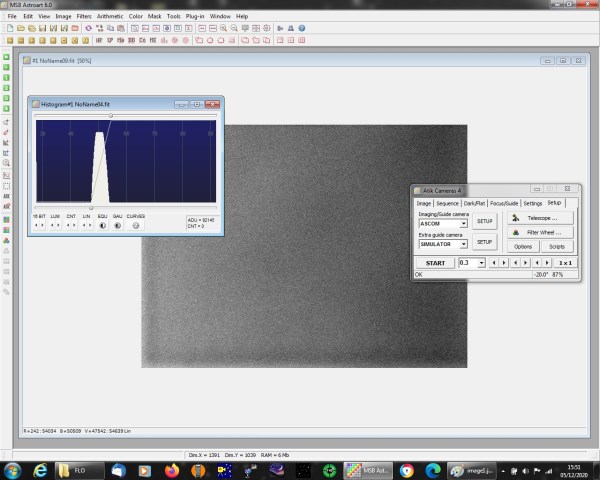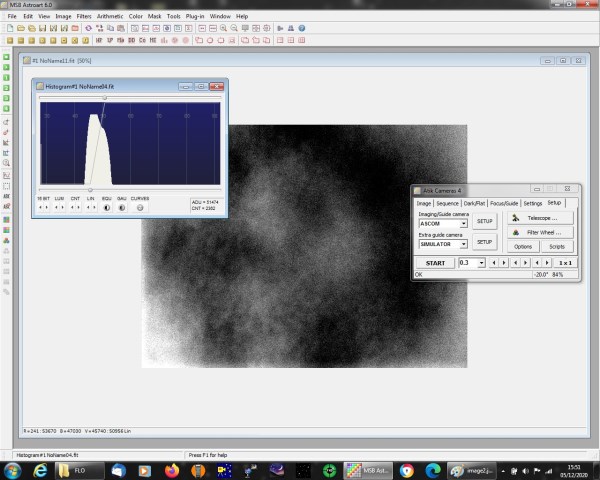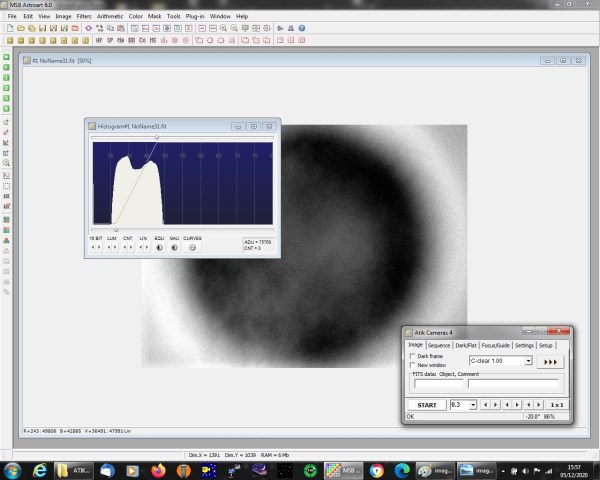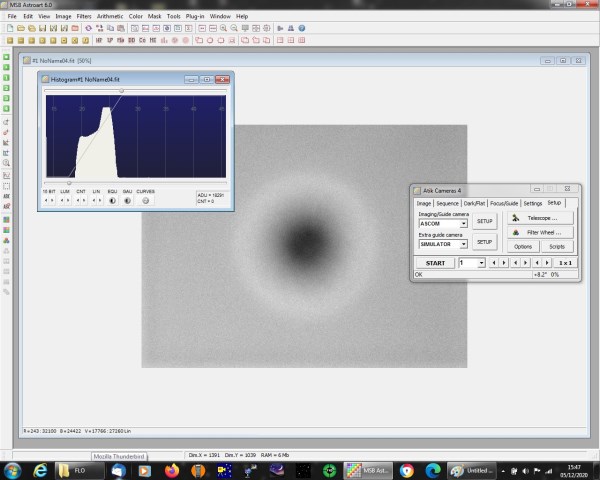- This topic has 6 replies, 4 voices, and was last updated 5 years ago by
 Rodger King.
Rodger King.
-
AuthorPosts
-
8 December 2020 at 5:22 pm #574817
 Rodger KingParticipant
Rodger KingParticipantI am having some difficulty with my old ATIK 314L+ CCD camera. I havn’t used it for a while and when I did I never bothered to take any flats as the pictures were generally very good. However, I thought now was the time to get some flats but when I do I am getting strange results.
As soon as I switch on the camera I send it down to -20C which is the temperature I plan to take all my images. This cooling only takes about 2 -3 minutes.
In this test I set up a flat screen, evenly illuminated and took a series of single flat images over a 20 minute period and as time went on the histogram got more and more wierd and what appear to be a de-sensitising of the central area of the chip. The data shows the central area becomes ~ 50% lower in values compared to the outer areas after 20 minutes.
- Image2 – shows the first image and the flat looks fine with an even histogram and relatively even image with some banding showing along the bottom and the left hand side. This is what I was expecting to see.

- image3 is about 2 minutes later. Blotching is starting to appear in the image and the histogram is no longer even.

- image4 is about 4 minutes later. Blotching is starting to disappear in favour of a darker central region and brighter rim. The histogram has 3 distinct peaks now.

- image5 is about 5 minutes later. Blotching has lamost gone now and the histogram has two almost equal peaks.

- image1 is the final image after about 20 minutes later. Blotching has all gone and the second peak on the histogram is now dominating.

I have also had a go at taking some new images. I see the same effect appearing on images too.
Does this indicate the camera is faulty ?
8 December 2020 at 10:37 pm #583492 Nick JamesParticipant
Nick JamesParticipantIt certainly looks optical rather than electronic to me. I can’t think how an electronic failure could cause this. Could it be frost forming on the sensor? That is normally only a temporary problem but I can’t think of anything else that would have such a weird effect.
9 December 2020 at 12:18 am #583495 Robin LeadbeaterParticipant
Robin LeadbeaterParticipantIt could be the desiccant tablet needs changing. This is easy on the later ATIK cameras but you have to take the back off the 314 to get to it. I have not yet had to do it but have this page bookmarked in case I do
https://forums.atik-cameras.com/index.php?topic=571.0
Cheers
Robin
10 December 2020 at 3:45 pm #583523 Rodger KingParticipant
Rodger KingParticipantThanks for these responses. I will check the desiccant. It was a duey night.
12 December 2020 at 3:02 am #583545 David ArdittiParticipant
David ArdittiParticipantIt’s water in the camera. Common problem in the UK: telltale point is pattern changing as the camera cools.
You need to dry the camera out. Putting it in a warm, dry place for some days might suffice, without having to take it apart.
My preventative solution to this is to keep a dew heater round the nose of the camera and switch it on at least 15 minutes prior to imaging. Sometimes I’ve kept the heater on for days to dry the camera fully.
12 December 2020 at 12:26 pm #583546 Robin LeadbeaterParticipant
Robin LeadbeaterParticipantLiving near the wettest place in England, dewing is ever present hazard for me but with this specific ATIK camera model which I have been running for many years the only time I have had a dewing problem has been when water got into an SCT when it got rained on making the air inside the telescope particularly humid. The dew then was on the outside of the camera window and drying out the telescope solved the problem. If this is a reoccurring problem (eg with an open tube telescope) this is where a specific dew heater for the camera could help. The other possibility though is dewing internal to the camera, either on the inside of the camera window or on the sensor cover glass (this can actually be frost if the sensor is cooled,as here). In the ATIK cameras, this is prevented by making the chamber in front of the sensor hermetically sealed and the air kept dry by a desiccant tablet. If the dewing is on the inside it is because the air in the chamber has become wet (either over time or because the seal has failed) In this case opening the chamber in a warm dry environment, introducing dry air and recharging the desiccant as ATIK recommend will solve the problem, though the solution may be temporary if the chamber is leaky.
Cheers
Robin
12 December 2020 at 5:28 pm #583548 Rodger KingParticipant
Rodger KingParticipantAlthough dewing and the desiccant sounded the potential problem, it turned out to be something else.
As I dismantled the camera off my telescope to prepare to dry the desiccant, I noticed the fiield flattener I was using on my refractor looked a little dirty. However, when I tried to clean it it seems the dirt is caught between layers of the flattener I cannot reach. See image.

Oddly the appearance of this dirt varies and a stable room temperature looks like it completely disappears. Must be at its worst when its super cooled ?
So I redid my flats with the field flattener removed and the images are all fine and do not change over time. So no need to dry the desiccant.
However I have had to send the field flattener back to the company I bought it from to be professional cleaned.
Still very grateful to you for your advice though.
-
AuthorPosts
- You must be logged in to reply to this topic.
